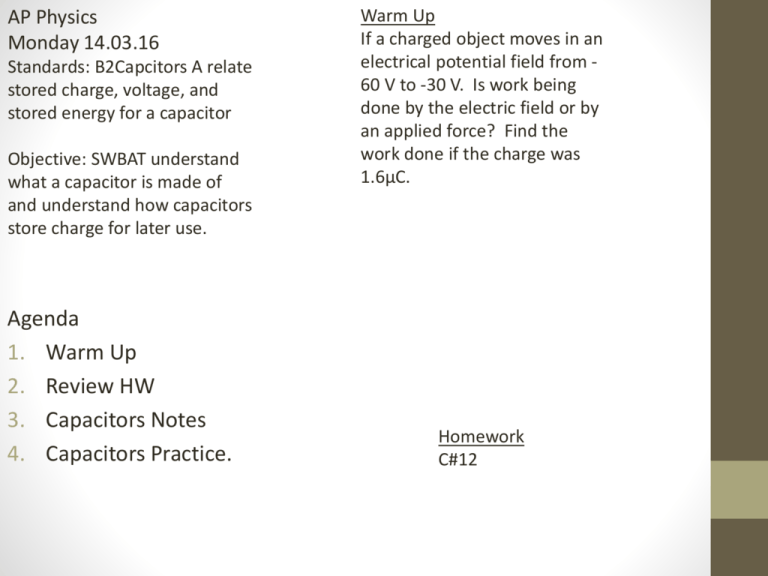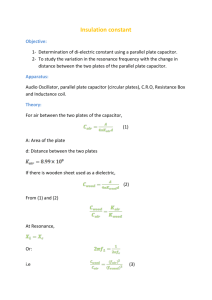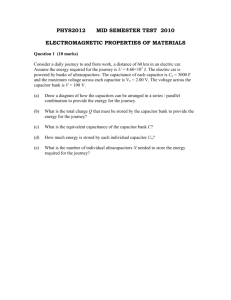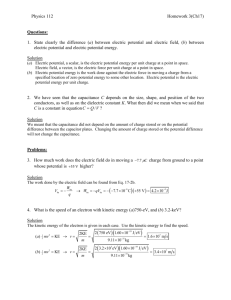14.03.17APWeek28ElectricCircuits
advertisement

AP Physics Monday 14.03.16 Standards: B2Capcitors A relate stored charge, voltage, and stored energy for a capacitor Objective: SWBAT understand what a capacitor is made of and understand how capacitors store charge for later use. Agenda 1. Warm Up 2. Review HW 3. Capacitors Notes 4. Capacitors Practice. Warm Up If a charged object moves in an electrical potential field from 60 V to -30 V. Is work being done by the electric field or by an applied force? Find the work done if the charge was 1.6μC. Homework C#12 AP Physics Tuesday 14.03.17 Standards: Identify parallel and series circuits & calculate their equivalent resistance. Objective: SWBAT solve problems involving multiple resistors Warm Up NO CLASS Agenda 1. Warm Up Homework AP Physics Wednesday 14.03.18 Standards: C2 a,b, students should understand current, resistivity, and the relationship between current and voltage. Objective: SWBAT solve problems involving simple circuits. Agenda 1. Warm Up 2. Review HW 3. Circuits Warm Up Find the capacitance of a parallel plate capacitor with an Area of 10 cm2 and an plate separation distance of 0.6 m. Homework C#13 AP Physics Thursday 14.03.19 Warm Up Find the current of an electric circuit with a resistance of 10Ω and 5V? Draw a circuit diagram. Standards: Identify parallel and series circuits & calculate their equivalent resistance. Objective: SWBAT solve problems involving multiple resistors Agenda 1. Warm Up 2. Review HW 3. Pass out Permission Slip Forms Homework C#14 AP Physics Friday 14.03.20 Standards: Power, Series & Parallel Combined Circuits Objective: SWBAT find the power used in electric circuits Warm Up Req=? 10Ω 12Ω 20V 6Ω I=? Vdrop across each resistor=? Agenda 1. Warm Up 2. Review HW 3. Series & Parallel Mixed Circuits 4. Power in Electric Circuits. 5. E#15 Homework E#15 8Ω Capacitance Guided Practice Consider a parallel-plate capacitor the size of Nauru, an island with an area of just 21 km2. If 100 V is applied across the capacitor to store 55J of electrical potential energy, what is the capacitance of this capacitor? If the area of its plates is the same as the area of Nauru, what is the plate separation? d=2 cm Capacitance: Fahrrads (Coulomb/Volt) – Stored charge per volt. Uc=(1/2) QV, Q2/2C, (½)CV2 C=εoA/d Q=CV C#12 Capacitance HW a. C=? Q= 1μC V=10 V 1. 2. 3. b Q=? C=10C/V E=10N/C D=2m c. C=? A=12m2 d=20m ε0=8.85x1012C2/(Nm2) d. Q=? A=1m2 d=10cm V=5V e. Find U for a,b,&d. To improve the short-range acceleration of an electric car, a capacitor may be used. Charge is stored on the capacitor’s surface between a porous composite electrode and electrolytic fluid. Such a capacitor an provide a potential difference of nearly 3.00x102V. If the energy stored in this capacitor is 17.1 kJ, what is the capacitance? Air becomes a conductor if the electric field across it exceeds 3.0x106V/m. What is the maximum charge that can be accumulated on an air-flled capcaitor with a 0.2 mm plate separation and a plate area equal to the area of the worlds largest painting (6.7x103m2) The largest lasagna in the world was made in California in 1993. It had an area of approximately 44 m2. Imagine a parallel-plate capacitor with this area that is filled with air. If a potential difference of 30.0 V is placed across the capacitor, the stored charge is 2.5μC. a. Calculate the capacitance of the capacitor b. Calculate the distance that the plates are separated. c. Calculate the electrical potential energy that is stored in the capacitor. 1985B3. An electron initially moves in a horizontal direction and has a kinetic energy of 2.0 x 103 electron–volts when it is in the position shown above. It passes through a uniform electric field between two oppositely charged horizontal plates (region I) and a field–free region (region II) before eventually striking a screen at a distance of 0.08 meter from the edge of the plates. The plates are 0.04 meter long and are separated from each other by a distance of 0.02 meter. The potential difference across the plates is 250 volts. Gravity is negligible. a. Calculate the initial speed of the electron as it enters region I. b. Calculate the magnitude of the electric field E between the plates, and indicate its direction on the diagram above. c. Calculate the magnitude of the electric force F acting on the electron while it is in region I. d. On the diagram below, sketch the path of the electron in regions I and II. For each region describe the shape of the path. C#13 Circuit Basics 1. 2. 3. 4. 5. Draw the symbol for resistor. Draw the symbol for current. Draw the symbol for voltage. Draw a simple circuit with 1 resistor. If 3x104C of charge flows across a point in a wire in 500 s, what is the current passing through that point in the wire? 6. If the electric current flowing through a wire is 4 A, how long will it take for 1μC to flow through the wire? 7. Find the amount of resistance in a circuit that turns on a light bulb if a 9 V battery pushes or drives the 0.33 Amp current. 8. Find the voltage that drives a 10 A current traveling through a wire if the resistance of 20Ω. 9. What is the resistance of a cupper wire with a radius of 0.5 cm and a length of 2000 m when the resistivity is ρal=1.70x10-8m? 10. Find the resistivity of an unknown metal wire with a radius of 20 cm and a length of 4 meters which produces a resistance of 1 Ω E #14 Series & Parallel Circuits For each: Find Req, then find the unknown currents and voltages. 2. 1. 4Ω 2Ω 4Ω 2Ω 3A 10V 6Ω V 6Ω 3. I 2Ω I2 4Ω I I3 4Ω 4Ω 2Ω C I1 I 4. 24V 24V I1 I2 E#15 Electric Circuits FRQ 1976B3. In the circuit shown above, the current delivered by the 9-volt battery of internal resistance 1 ohm is 3 amperes. The power dissipated in R2 a. Determine the reading of voltmeter V in the diagram is 12 watts. b. Determine the resistance of R2 c. Determine the resistance of R1 1986B3. In the circuit shown above, X, Y. and Z represent three light bulbs, each rated at 60 watts, 120 volts. Assume that the resistances of the bulbs are constant and do not depend on the current. a. What is the resistance of each bulb? b. What is the equivalent resistance of the three light bulbs when arranged as shown? c. What is the total power dissipation of this combination when connected to a 120-volt source as shown? d. What is the current in bulb X? e. What is the potential difference across bulb X? f. What is the potential difference across bulb Z ?
![Sample_hold[1]](http://s2.studylib.net/store/data/005360237_1-66a09447be9ffd6ace4f3f67c2fef5c7-300x300.png)





